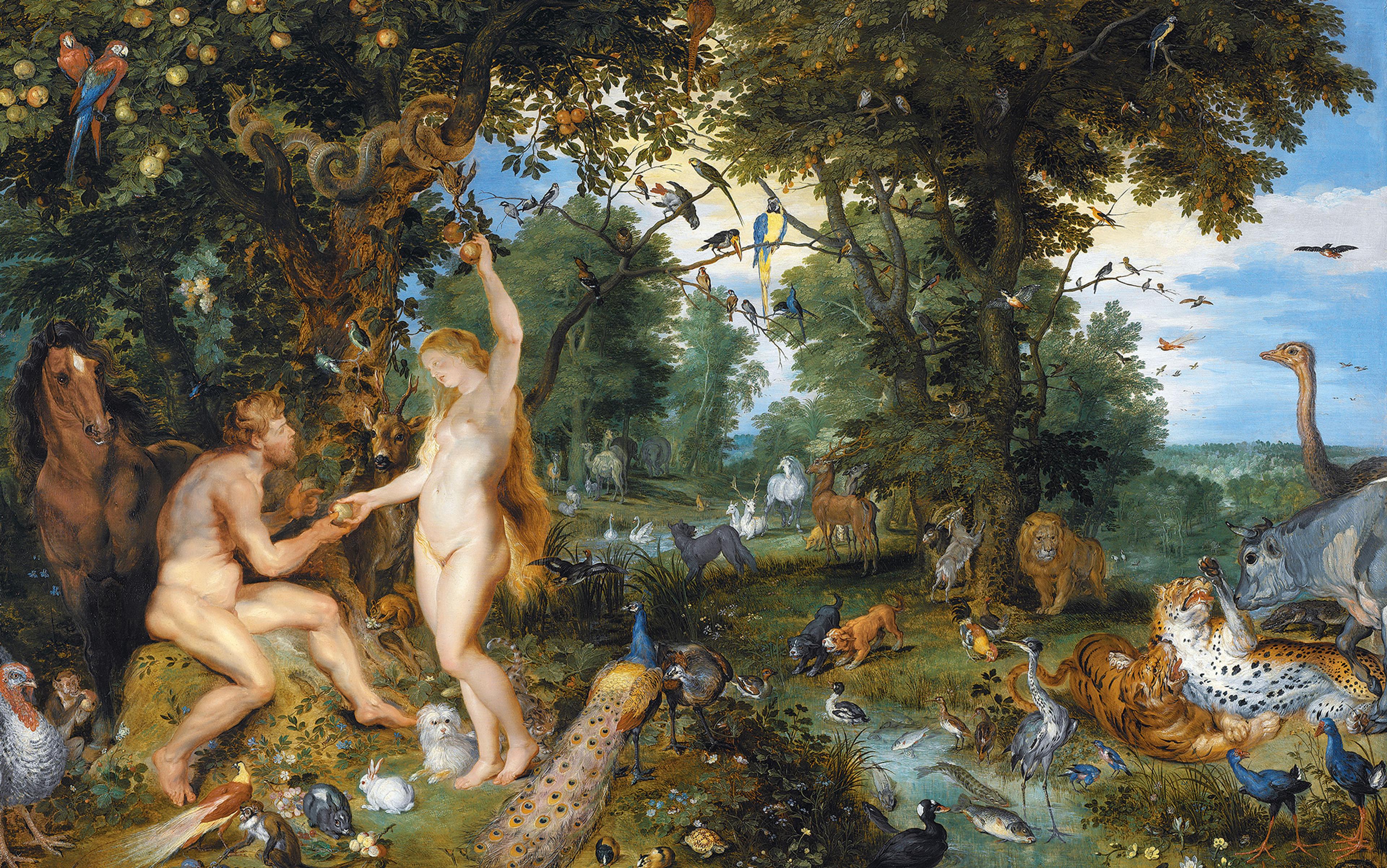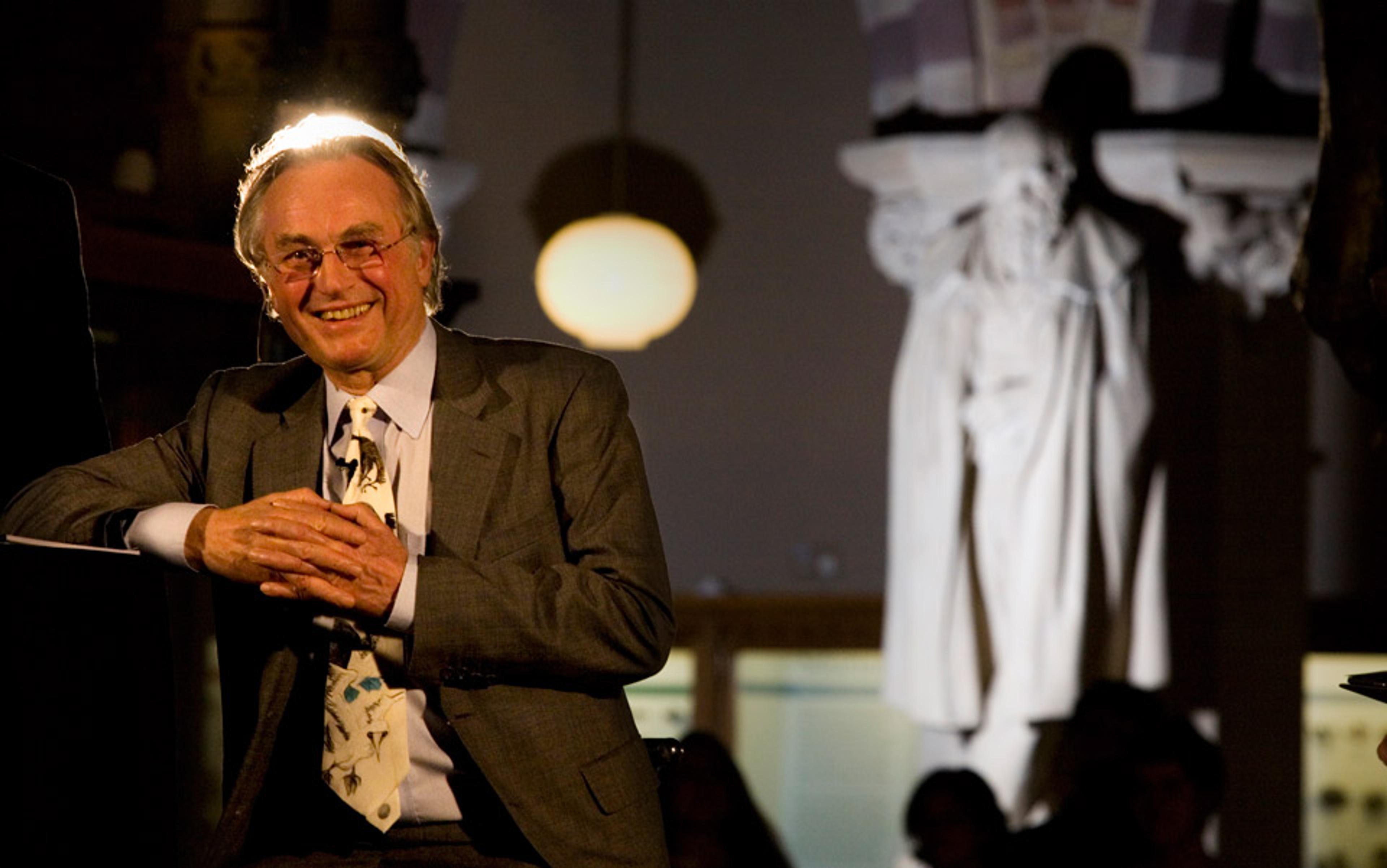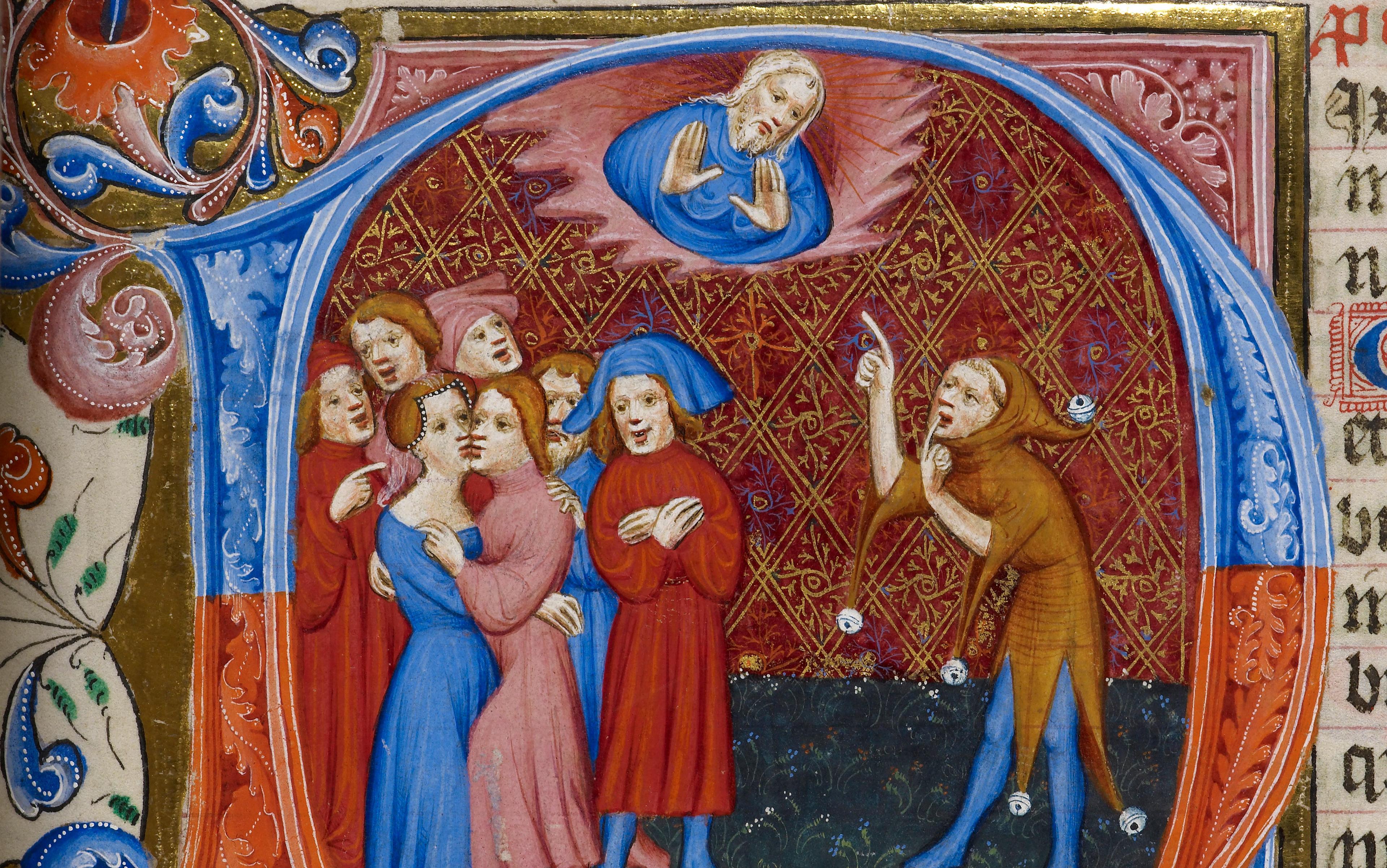The first thing I learned about natural theology was that it was wrong. The idea that God’s existence could be proven by simply observing life on Earth – that divine presence could be found in human eyes, the wings of bees, the order of orchids or the movements of the planets – seemed archaic in a secular world where science reigned. And by the late 20th century, even those who rejected this secular world had started to turn away from natural theology: in the United States, evangelical Christians and other groups looked to the Bible, not nature, to justify their values. The very grounds of natural theology became something worthy of parody. I remember the British author Douglas Adams’s depiction of the Babel fish in The Hitchhiker’s Guide to the Galaxy (1979). This improbable living creature could provide instant universal translation to anyone who placed it inside their ear canal. For Adams, its existence served as the definitive disproof of a deity:
The argument goes something like this: ‘I refuse to prove that I exist,’ says God, ‘for proof denies faith, and without faith I am nothing.’
‘But,’ says Man, ‘the Babel fish is a dead giveaway, isn’t it? It could not have evolved by chance. It proves you exist, and so therefore, by your own arguments, you don’t. QED.’
‘Oh dear,’ says God, ‘I hadn’t thought of that,’ and promptly vanishes in a puff of logic.
Adams’s fantastical parody of the design argument came at a time when natural theology was increasingly regarded as both obsolete and absurd. Just under a decade later, Richard Dawkins wrote The Blind Watchmaker (1986), which also took aim at arguments that God was revealed through the natural world. Dawkins wrote that there was compelling evidence and logic behind the natural theology arguments of previous centuries – particularly those made popular by the British clergyman and philosopher William Paley in 1802 – but that these arguments had been rendered obsolete by Charles Darwin’s accounts of living creatures that were not designed. Instead, they had ‘evolved by chance’. By the early 1990s, even antievolutionists were latching on to a version of this argument. These groups, including evangelical Christians in the US, claimed that the fault was not in natural theology’s inherent logic, but in the out-of-date scientific examples that informed its argument. All of this came to a head in 2005, during the Kitzmiller vs Dover Area School District court case in the US, which determined whether intelligent design could be taught in a Pennsylvania school’s biology classes. The opposing sides in the courtroom could agree on only one thing. The central question of natural theology, they affirmed, was this: Can a God, creator, or ‘Intelligence’ be proven to exist? This is the version of natural theology we inherit today. The problem is, reducing natural theology to a question of proof loses much of what it stood for. If the first thing you learned about natural theology was that it was wrong, the second should be that you didn’t really learn about natural theology – you learned a truncated version rooted in historical misunderstanding.
During the past millennium, the arguments for natural theology were about much more than proving God’s existence. Natural theology advocates were not writing to merely dissuade atheists; their foils were other religious believers whose doctrinal or denominational differences might be arbitrated by the public evidence of empirical science. Natural theology was never about ‘proof’ as we have come to understand it. We see this in the writings of the Italian friar Thomas Aquinas in the 13th century; in the works of the English naturalist John Ray and the clergyman Paley in the 17th and 18th centuries; and among myriad other texts, including the eight Bridgewater Treatises, commissioned in 19th-century England to document the ‘goodness of God as manifested in Creation’. For natural theologians, the specific line of reasoning used to arrive at a ‘proof’ of God determined the kind of answers one could reach about moral and political questions, about the nature of salvation, the toleration of other faiths, and the validity and interpretation of scripture. Natural theology was never exclusively about proving God’s existence through the complexity of the natural world. And yet, our contemporary rejections of natural theology have focused almost exclusively on this argument. Natural theologians and philosophers were instead motivated by a search for answers to the pressing moral and political questions of their day, and their arguments were as much about considering the epistemological grounds of proof, as they were about finding God in nature.
To understand how the natural theologians made their arguments requires us to understand the purpose of ‘proof’ differently. Many of the arguments put forward by Aquinas, Ray, Paley and others follow specific rules of reasoning. They also follow commonly accepted rules of logical inference and conventions of citing publicly observable matters of fact. And yet, the demonstrations of ‘proof’ made by these writers – that is, descriptions of the natural world – also served as a literary genre through which rhetorical and emotional appeals could be made that go beyond logic. At the time when they were published, these appeals to rhetoric and emotion would not just have been seen as displays of wit or cleverness. They also showed an understanding of how humans think: an expression of how nature and divinity can open one’s mind and spirit to be moved and persuaded. Perhaps anticipating what scholars of psychology and communication would only conclude centuries later, natural theologians knew that people are rarely persuaded by reason alone.
Although Paley is less well known than the two other scholars he is most often contrasted with, David Hume and Darwin, his examples of natural theology remain ubiquitous today – and, for that reason, also distorted. Paley’s book Natural Theology: Or, Evidences of the Existence and Attributes of the Deity (1802) begins with perhaps the most misinterpreted discussion in the entire history of theology: the analogy of the watch. Should a person happen to come across a stone, Paley argued, one would not draw grand conclusions from it. But upon stumbling across a watch, a reasonable observer would quickly grasp that its many parts had been assembled for a purpose. There must be, he wrote, a kind of watchmaker. Paley later shows that the interpretation of the watch as something that has a purpose logically parallels how we might interpret various animal organs (eyes, ears, wings and more) and other natural systems as demonstrating purpose, too.
This ‘watchmaker argument’ is commonly described as an argument about origins and complexity. In calling his 1986 book The Blind Watchmaker, Dawkins argued that both watches and complex living things could have, in the terms of the Babel fish argument, ‘evolved by chance’. By this logic, if things such as body parts and living systems didn’t require an interventionist creator, then Paley’s argument crumbles. No creator? No purpose.
Except that Paley wasn’t writing in total ignorance of the theological arguments that had come before him.
Think of the argument about the initial creation of the observable world: the argument of the ‘first cause’. This is sometimes posed as a question, ‘Why is there something rather than nothing?’, which has taken on various forms since it was included in Aquinas’s Summa Theologica (written c1265-73). Hume, writing about a quarter-century before Paley, offered an incisive criticism of the first-cause argument, claiming that it was an error to presume that a deity or creative designer would have purposes akin to human ones, or that the analogy between human intentions and nonhuman ones could be justified through anything other than circular arguments.
Paley would have been familiar with these ideas, and his Natural Theology is partially an attempt to offer answers to the logical criticisms that Hume raised decades earlier. Paley’s opening comparison of the stone with the watch is one such answer – a response to Hume’s argument about first causes. By rejecting the idea that the stone provides useful evidence of a creator, Paley avoids the oversimplified argument that the existence of anything proves God’s existence. But the watch provides something different: evidence of purpose. That’s not the same thing as evidence of a creator. In a later chapter of the book, Paley considers the possibility of a mechanical watch-like object that creates a replica of itself. Logically, these self-replicating watches were directly created by their predecessors, and the watch could have been the most recent generation of an infinite cycle of reproducing watches that exist eternally. Paley avoids discussion of first causes to sidestep, rather than refute, Hume’s criticism, and focus his logic instead on the question of purpose.
For Hume, purpose could not be proven without presupposing that God had an anthropomorphic nature, with desires, goals and plans like our own. We can’t assume, he argued, that a God has the same purposes as human artisans. Paley’s argument took a different direction. His view that nature has purposes is based on observations that objects seem adapted to make use of natural laws even when those laws did not play a direct role in fabricating them. A watch uses its springs, chains and other mechanical laws in a way that coincides with astronomical laws that define the day. Observing this, we may infer that there is a purpose found in the ability of the material world to make use of natural laws. Paley is suggesting that Hume’s argument can be cleaved in two: whether purposes can be revealed by objects in nature is a separate question to understanding exactly what those purposes are. For Paley, we observe this through the parts of the eye that seem arranged to make use of the laws of optics, or through birds’ wings that make use of aerodynamics, or through an ear’s expression of acoustic principles. We can observe this adaptation even if we don’t understand sight or flight.
This argument was intended as a logical response to Hume. But, more importantly, it unveils an expanded view of Paley’s beliefs. This version of natural theology reveals a deity who is known not by the instances where science fails, but at the moments when it most elegantly works. The reductive ‘argument from design’ so often faulted by atheists and praised by antievolutionists suggests God is the best explanation remaining whenever we can’t account for why things came to be as they are. It’s based on a thin process of elimination – with a vision of a creator that the Scottish theologian Henry Drummond derided as the ‘God of the Gaps’ – and it can testify to nothing other than mere existence. By contrast, and design, Paley’s arguments are focused on getting beyond existence to questions of the attributes of the designer. In his view, because natural laws are found universally on Earth and beyond, then surely the author of those laws is both singular and omnipresent. More debatably, Paley’s writing indicates that the world seems to minimise purposeless suffering and permits creatures to experience pleasure without any apparent ulterior purpose – a suggestion that there is goodness in the governance of the world.
To understand Paley’s argument, readers had to exist in a society that built, sold, regulated and consumed watches
This latter point gets at the heart of ethics and politics in Paley’s day. In The Principles of Moral and Political Philosophy (1785), Paley responds to the question of whether (and by what means) a well-ordered society would prove naturally beneficial to its inhabitants. The reason for his affirmative answer was the chaos and suffering caused by the French Revolution, which he abhorred. He cautioned against the possibility of a similar uprising in Britain. Paley’s views were in conversation with those of the English economist Thomas Malthus, whose primary aim in An Essay on the Principle of Population (1798) was not simply to demonstrate that societies naturally and inevitably outgrow their resources, but that the suffering caused by population growth was neither inherently the result of failed governance nor incompatible with the moral edicts prescribed by a good and caring God.
Paley’s awareness of and conversation with the political and economic order of the day plays a key role in his arguments for natural theology, in particular his example of the watch. In his day, the people who fabricated individual parts of timepieces – chains, gears, dials and faces – were not considered ‘watchmakers’ (nor were those who assembled those pieces). That title was accorded only to those who supervised and managed such people. When Paley’s Natural Theology was published in 1802, he understood that English watchmaking was a geographically and financially complex industry that had as many moving parts as individual watches themselves. This context changes the nature of the watchmaker argument considerably. To fully understand Paley’s argument, readers of his Natural Theology had to exist in a society that built, sold, regulated and consumed watches, a society in which timepieces had become objects of form and fashion. To even consider the argument’s merits, one must already be part of a complex human mechanism that relied on the adaptation of human parts to a unified purpose. In this way, the argument is self-confirming in a more convincing way than any argument that God exists because existence is a necessary attribute of God – the ontological argument for a ‘God of the Gaps’.
In October 1802, weeks after Natural Theology was published, Paley received a letter from Bishop John Law, his close friend, former schoolmate and intellectual confidant. Paley had dedicated his first major work, The Principles of Moral and Political Philosophy, to Law’s father, who was the Bishop of Carlisle and a patron and supporter of Paley. Having just read Natural Theology, Law told Paley that his ‘arguments for the divine goodness are so strong, that not only our reason is convinced, but as Barrow would say, “we even touch and feel it with our senses.”’
Law quotes from a published sermon by the 17th-century English mathematician and theologian Isaac Barrow, perhaps best known as Isaac Newton’s mathematics teacher at Cambridge. Barrow draws from both the Book of Psalms and from the evidence of nature to explain ‘the Goodness of God’:
The Earth is full of the goodness of the Lord: The Earth, O Lord, is full of thy Mercy. Thy Mercy is great unto the Heavens; thy Mercy is great above the Heavens. ’Tis indeed because Divine Goodness is freely diffusive and communicative of it self …
For Barrow, the goodness of God, which is attested to throughout the Psalms, is also demonstrated to us by the sensual ways in which it is experienced:
Every pleasant object we view, every sweet and savoury morsel we taste, every fragrancy we smell, every harmony we hear; the wholesome, the cheering, the useful, yea, the innocent and inoffensive qualities of every thing we do use and enjoy, are so many perspicuous arguments of divine goodness; we may not only by our reason collect it, but we even touch and feel it with all our senses.
Barrow’s sermon remained topical enough 125 years after his death that Law would quote it in a personal letter to his old friend. This says much about the long tradition of natural theology as an engagement of embodiment and emotion, through touching, feeling and sensing in ways that are separate from, though perhaps complementary to, our faculties of logic and reason.
That history extends from Barrow through other natural theologians such as John Ray, whose book The Wisdom of God Manifested in the Works of the Creation (1691) provides an account of awe-inspiring contrivances of nature, and suggests that humanity was created with both the mental and physical abilities to perceive God’s wisdom. This synthesis of knowledge as both thinking and sensing was key to the emergence of empiricism, as exemplified by Barrow and Ray’s contemporary John Locke, and was deeply influential on both the theological and political thought of Edmund Law and Paley. Both believed that religious truths could be accessed through universally available human experience, making them staunch defenders of religious toleration. Unlike private revelation or doctrinally demanded interpretations of scripture, the evidence of religious empiricism – sensing and feeling God – could arbitrate the long history of religious disputes in England. For Law, Paley and others, religious toleration took the form of rejecting the mandatory oath-taking required in England to hold office or access society. They argued that the moral harm from swearing false oaths caused greater spiritual damage than believing in the wrong doctrine.
Paley’s appeal to readers’ sensations as a form of argument is a practical application of his view of how the mind processes the emotions that come from sensory experience. He discusses this early in The Principles of Moral and Political Philosophy, which leads him to navigate a morally conservative tightrope, insisting that experiences of pleasure and happiness were necessary to understanding God, but also that overindulgence in pleasurable experience for its own sake makes divine knowledge harder to grasp. Paley notes that over time and through repetition the emotional force of a sensation becomes ‘blunted’. Paley suggests that this blunting of the emotional response to certain sensations comes from the strengthening or relaxation of the fibres of the nervous system. Much later in his same work, he suggests that the biblical injunction against taking the name of God in vain may be understood as a caution against ‘that familiar levity with which some learn to speak of the Deity’ – a deity who should evoke feelings of awe and reverence. This injunction, which is at the heart of Paley’s concern about false oaths, is not merely about moral harm; it’s also about one’s easily blunted ability to grasp an embodied knowledge of God.
And yet, upon opening Natural Theology in 1802, Paley’s first readers did not engage with his new book with all their senses directly. The texture of cut quarto pages, the smell of leather binding and the visual contrast of ink on paper are not what revealed God to them. Rather it was a remembered sensory experience, built upon Paley’s expectation that his readers have been in the world, observed birds in flight and caught the scent of flowers in bloom. They’ve looked at the lights in the night-time skies and they’ve heard the ticking of their watches. Paley relies upon that shared context of observing, sensing and knowing. His words contrive to evoke memories of moments of awe, experiences of beauty and wonder. However, this was often done with such skill that Paley was later dismissed as a populariser or educator rather than a theologian engaged in original argument and analysis.
They saw evolution not as a logical disproof of God, but as a tangible demonstration of divine power
In truth, natural theologians such as Paley and his successors were often doing both, and finding success in doing so for a variety of reasons. Their writing was not just a pragmatic marriage of natural philosophy and religious pluralism; nor was it a simple rejection of either the a priori rationalism that so often characterised continental European philosophy or the mystical-revelatory religious knowledge that took hold in some evangelical Christian movements in the 19th century. The English-language religious tradition of that period did not reject Darwin’s theory of evolution as incompatible with a Genesis account of creation or as a rejection of theism. This was not merely an attempt to broker a ceasefire between the opposing forces of science and religion. And it was not simply a compromise of compatibility. Rather, it was born out of a strong sense that the natural world revealed divine knowledge in a way that could be expressed logically and appeal extra-logically to emotion and sentiment. Many readers of Natural Theology have understood that a deity must be known not only through reason, but also sensed and felt.
This commitment to logic and feeling remained, even as new scientific discoveries compelled revisions to some of the naturalistic explanations that prior natural theologians had pointed to. By the 1830s, some editions of Paley’s Natural Theology contained a footnote stating that it was now possible to explain not just the watch but also how the stone came to be. Paley’s own writing, which Law had praised for its ability to evoke sensory memory, helped natural theology inspire a subgenre that gradually became what we call ‘popular science’ or ‘nature writing’.
The union of logic and feeling reveals itself through theologian-scholars such as the US botanist Asa Gray and the English historian Charles Kingsley, who embraced Darwin’s theory of evolution in the 1860s. These same scholars also embraced the idea of a deity who could have enabled the living world to evolve into complex life, which they saw as testament to the wisdom, power and benevolence of a creator (one who hadn’t simply created each species on an ad hoc basis). They saw evolution not as a logical disproof of God, but as an evocative and tangible demonstration of divine power, one that was felt every day in their own bodies.
However, efforts to promote more secular versions of science and less politically pluralistic interpretations of Christianity eventually came to dominate not just the debate over evolution, but the broader discussion of ‘science and religion’. To some concerned Christians, natural theology became associated with efforts to analyse the Bible through scientific tools and was subsequently derided as anti-Biblical. For them, biblical authority, not natural theology, was at the root of science-religion conflicts in the early 1900s. After the Second World War, English-language scientists tried to distinguish themselves from the militant atheism of their Soviet rivals, while also distancing themselves from caricatures of creationist fundamentalism. The compatibility of science and religion took hold as a logical possibility: one could now be both scientist and Christian. And so, over time, the work of Paley, Ray, William Buckland and many others was thinned out, and relegated to a mere God-proof that could, at best, be mounted as a defence against scientific debunking.
By the mid-20th century, natural theology was dying of the slow strangulation of faint praise. It was nothing more than a misguided – if clever and well-intended – attempt to prove that God exists without any recourse to scripture or revelation. The US scholar Ian Barbour, widely recognised as one of the founders of the interdisciplinary field of ‘science and religion’, rejected the fundamental premise of natural theology when he wrote in 1966 that ‘theology should not be based primarily on nature’. Instead, Barbour suggested doing ‘theology of nature’ – something that was not natural theology. The primary difference seemed to be that one would do theology of nature from within a religious tradition, that is, after one was already convinced (by other means than nature) that there was a God worth doing theology about.
By the end of the century, this caricature of natural theology as a vaguely Christian effort to use nature to prove that God is real had taken root among both outspoken atheists and antievolutionists who had been compelled by American court rulings to demonstrate that they had an alternative to natural selection that was ‘scientific’. This version of natural theology’s aims and origins became a rare point of consensus between those who wanted to prove that God didn’t exist (thanks to Darwin) and those who wanted to prove that something exists (even if they couldn’t say exactly what). It was further abetted by acolytes of Barbour and those of the science-religion ‘dialogue’ whose positions rarely moved beyond statements that science and religion were logically or technically compatible. Mere existence, therefore, became the minimal and ultimate stakes for the argument from design – a profoundly reductive vision of natural theology.
Intelligent Design and New Atheism converge on questions about the ethical and political nature of science
The erasure of the psychological and rhetorical complexity of natural theology – that is, its recourse to embodied knowledge – has had a damaging effect on religious philosophy in recent decades. It’s contributed to the persistence of a so-called Intelligent Design movement, which, for years, has focused on trying to prove the existence of an intelligent agent without fully acknowledging or seeming to care that specific approaches to such proofs have implications for theology, politics or ethics. At the same time, the reduction of natural theology into a kind of logical proposition has allowed those who reject its repackaged proposition – such as the ‘New Atheists’ – to assert that the disproofs of God and the secular science that they claim to be doing are value-neutral, apolitical and objective.
On the surface, it appears that Intelligent Design and New Atheism fundamentally disagree about the nature of biological evolution. However, the erasure of their shared intellectual history has allowed both movements to converge on more fundamental questions about the ethical and political nature of science. And often, they’ve done this without acknowledging either their own biases or the ways that these arguments are inseparable from the cultural uses to which they are put. To get past the senseless duality that these two movements offer us, we may have to follow Law and Barrow, recalling that, in the synthesis of religion and science, ‘we even touch and feel it with our senses’.






